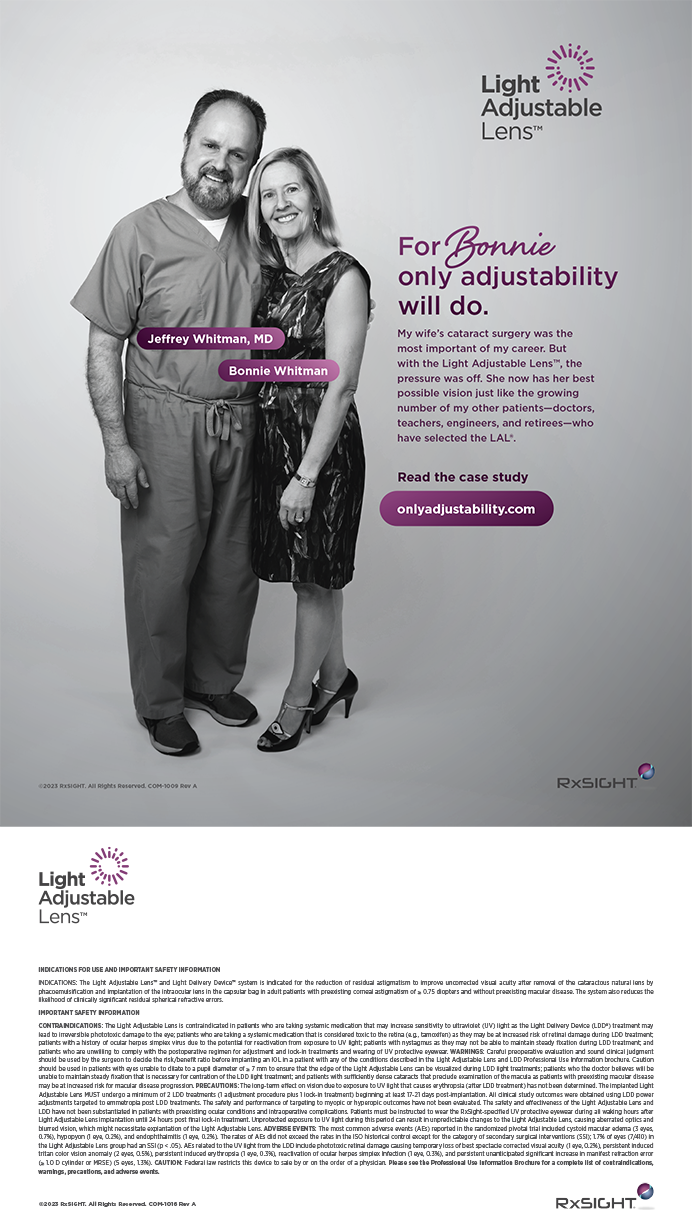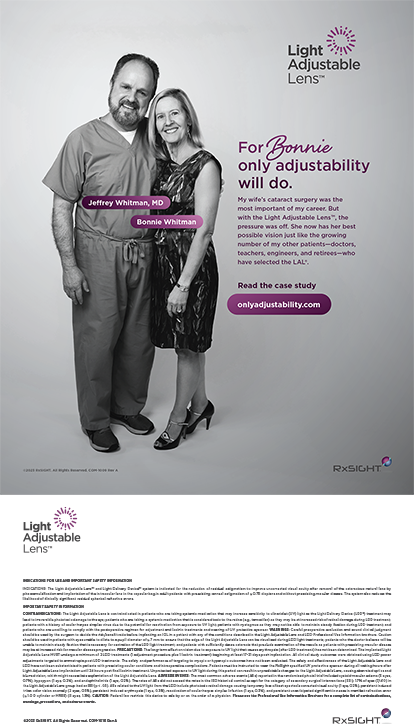




Have you received samples of presbyopia drops? Have you tried them yourself, and what was the experience like if so?
Vin T. Dang, OD, FAAO: Yes, I have received samples of Vuity (pilocarpine HCl ophthalmic solution 1.25%, Allergan), and at the time of writing this, I have been offering them to patients for about 3 weeks. I have not used them in my own eyes because I’m not presbyopic. I am hesitant to try them because, anecdotally, I have heard that the drops can cause a myopic shift in nonpresbyopic patients.
Marjan Farid, MD: Yes, I have received Vuity samples, and I have tried them in my own eyes. I am in the beginning stages of presbyopia, and although I have not started using readers yet, I have some difficulty reading up close. About 10 to 15 minutes after instilling the drops, I felt much more comfortable reading my cellphone up close and experienced less eye strain. I was pleasantly surprised to have experienced no side effects. The effects of the drops lasted about 3 to 4 hours.
Michael Patterson, DO: This question made me laugh because I am too young to be presbyopic, but I often joke to myself in the clinic that I don’t know what I’ll do when I need to wear reading glasses because of how much of my day-to-day work would require them. We did receive samples in my practice, and we have utilized those. Multiple staff members have tried them and have enjoyed the experience. Nobody has reported any side effects so far. The effects of the drops seem to last about 8 hours, and everyone I’ve given them to so far has been able to read comfortably in the clinic setting. I even gave them to a golf professional, and he loves them.
Sheri Rowen, MD, FACS: Yes, I have received samples and tried them myself. I am pseudophakic, and I was hopeful. The drops, however, didn’t improve my near vision, and I experienced dimming. Additionally, I have given them to some patients who are in their late 50s to early 60s who also did not obtain the benefits. I have many patients in their mid-40s to early 50s who are using the drops successfully. They reported experiencing less strain while reading with use of the drops and that the effects lasted about 4 to 8 hours. This seems to be an exciting new option for younger presbyopes.
Vance Thompson, MD, FACS: We have received the Vuity drops. I have not tried them because I am not presbyopic. When patients ask whether I need readers, I tell them I do not and that when I do start noticing a need for them, the drops will be the first thing I try. We were in the FDA-monitored trial for Vuity, and these drops worked for many patients.
Do you plan to offer presbyopia drops as a treatment option? If so, how are you going to work them into clinic day flow?
Dr. Dang: Absolutely. The indication for this medication is so broad—I’m trying it on everyone who qualifies. I identify potential patients during their regular checkups. I tell them that there is a new medication approved by the FDA to help with their blurry near vision, and I educate them about presbyopia. Then, I schedule interested patients for a 20-minute, in-office trial to make sure they don’t have any negative side effects and so that they can experience the wow effect of the drops while they are in the clinic.
Dr. Farid: The first group of people I have prescribed Vuity for have been my friends, relatives, and acquaintances. Many of them were unlikely to see an eye care professional for regular exams but were excited about these drops. So far, the feedback has been positive. It seems that people with darker-colored irises have had fewer side effects and a generally better reading effect while lighter-colored eyes have had some more headache and dimming of light and distance vision. This is, of course, anecdotal and based on the experience of a few patients.
I don’t see patients with so-called normal eyes very often because I practice in a tertiary care referral center. I therefore have not had the opportunity to prescribe these drops for the treatment of presbyopia in clinic, but I have prescribed them for off-label purposes in the clinic to patients who have multifocal IOLs and are experiencing halos and glare. I am waiting to hear back from these patients.
Dr. Patterson: In my practice, we ask every patient in the age range for presbyopia about whether they need glasses to read up close and, if so, whether they would consider a drop or other treatment option to address the issue. The real workflow problem for my type of practice will be if we have thousands of people wanting to come in to get a prescription for presbyopia drops. We’re so busy already—I see about 70 patients a day.
Dr. Rowen: I will be offering presbyopia drops as an adjunctive treatment alongside surgical procedures, and I will offer the drops to patients who have undergone monovision LASIK. If we have samples available, I will either have patients try them in the office or send them home with them, but it will be difficult if their vision cannot be fully corrected. To truly test the samples, patients will need to be able to put contact lenses in or wear glasses to correct their vision so they can see how they do with the drops at their best corrected distance vision.
The workflow in the clinic is still to be determined, but I think that patients will need a dilated exam to rule out any preexisting retinal conditions. Presbyopia drops will be an excellent entry point for many patients who have never had routine exams, and it will help create patient awareness of their eye health. Additionally, many patients will learn about their future options, including surgical procedures for correction.
Dr. Thompson: Yes, I’m using presbyopia drops for patients with early presbyopia and excellent distance vision who don’t want to use readers.
Pupillary miotics such as Vuity should not be prescribed without a thorough eye examination because there is an association between pilocarpine and retinal detachment—although no association was seen in the clinical trials.1 Because these patients might have forgone regular eye exams in the past, it’s a great opportunity to check their IOP, peripheral retina, and optic nerve to ensure there are no areas of concern that may require referral to a glaucoma or retina specialist. Additionally, this can ensure that patients who are prescribed presbyopia drops have no signs of ocular surface disease or cataracts. The use of miotics in patients with cataracts can further compromise their night vision. The examination is also a great time to inform patients about the treatment options available to them in the future when they may require surgical vision correction (see Filling the Gap).
Filling the Gap
By Vance Thompson, MD, FACS
I participated in the FDA clinical trials of Vuity (pilocarpine HCl ophthalmic solution 1.25%, Allergan). I’m also participating in trials of other presbyopia drops. I think eye care providers sometimes underestimate the impact that presbyopia can have on a person’s quality of life—whether it’s functional (eg, falls and injuries) or aesthetic (ie, not liking how they look in readers). There are many reasons why patients want to treat their presbyopia, and a growing array of options are available. Surgical approaches to presbyopia correction include multifocal IOLs, monovision, and laser vision correction. Until recently, however, there has been a gap in treatment options for patients who are not ready to have surgery but desire to see without readers. Presbyopia drops fill that gap perfectly.
I think presbyopia drops may increase the number of patients interested in surgical vision correction. Individuals who enjoy the spectacle independence provided by the drops may be more likely to seek a permanent approach to presbyopia correction.
Competitive Market
The drops currently available and under investigation have various mechanisms of action:
- Pupillary miotics;
- Drops that combine miosis with improved accommodation at the ciliary body; and
- Drops that improve the flexibility and accommodative ability of the crystalline lens.
I think, ultimately, the most successful product on the market will have a fast onset of action, a long duration of effect, no negative side effects, and no negative impact on the health of the ocular surface. I anticipate strong patient adherence with a drop that meets these criteria.
Conclusion
Presbyopia drops are a great addition to the options for presbyopia treatment. The drops offer an opportunity for eye care providers to establish a relationship with presbyopic patients that can carry through to their eventual surgical needs.
Do you educate patients on the availability of presbyopia drops and the considerations for their use such as side effects?
Dr. Dang: During patients’ in-office trials with the drops, I inform them of the most common side effects, such as headache and conjunctival hyperemia. I tell them that the drops can restore most of their functional vision and that they are available at all major pharmacies or can be ordered by the pharmacy and made available within 1 or 2 business days. I also let them know that the drops are not covered by insurance and will cost around $79 a month if they use them every day.
Dr. Farid: There is a lot of buzz and excitement about these drops already. The most important aspect of patient education is setting appropriate expectations. I want to make sure every patient understands what to expect. Whenever I prescribe the drops, whether it’s to a friend or a patient in the clinic, I inform them of the possible side effects—that there is a chance they could experience a headache or brow ache—and tell them that the duration of effect is about 3 to 4 hours.
Dr. Patterson: I don’t talk to patients too much about the side effects. As with any patient who has had presbyopia-correcting treatment, I tell them that they may notice that their vision is a bit darker with the drops and that they may require more light than usual.
Dr. Rowen: I will educate patients when I think it is appropriate or they specifically ask about presbyopia drops. In my practice, if we have brochures, we will give them out or use a QR code that patients can scan to view the educational information. We will write prescriptions as needed. I am genuinely not worried about the side effects, but I will advise patients that they may experience things like headache, burning, and stinging. I tell them to have someone with them the first time they try driving at night with the drops. This information will also be available in the educational brochure.
Dr. Thompson: My practice is surgical, and patients are often in my office for a surgical consultation. If I feel a patient could be a fit for presbyopia drops, I offer them as an option before surgery. In my experience, patients appreciate that I am doing what is in their best interest by offering drops as the first-line treatment for their presbyopia. They love having an easy, safe, and nonsurgical option to reduce their need for readers to see up close.
I inform patients that they may experience some stinging with instillation that typically wears off. However, most people in the study did not report experiencing this side effect. I also let patients know that they may need to supplement the drops later in the day as the effects wear off.
At Vance Thompson Vision, if a patient of one of our referring doctors calls our office about presbyopia drops, we refer them back to their primary provider to schedule an appointment. We then call that doctor to make sure they are comfortable in their knowledge about the drops and feel that they can speak to the patient about their contact lens and surgical options.
1. Beasley H, Fraunfelder FT. Retinal detachments and topical ocular miotics. Ophthalmology. 1979;86(1):95-98.




